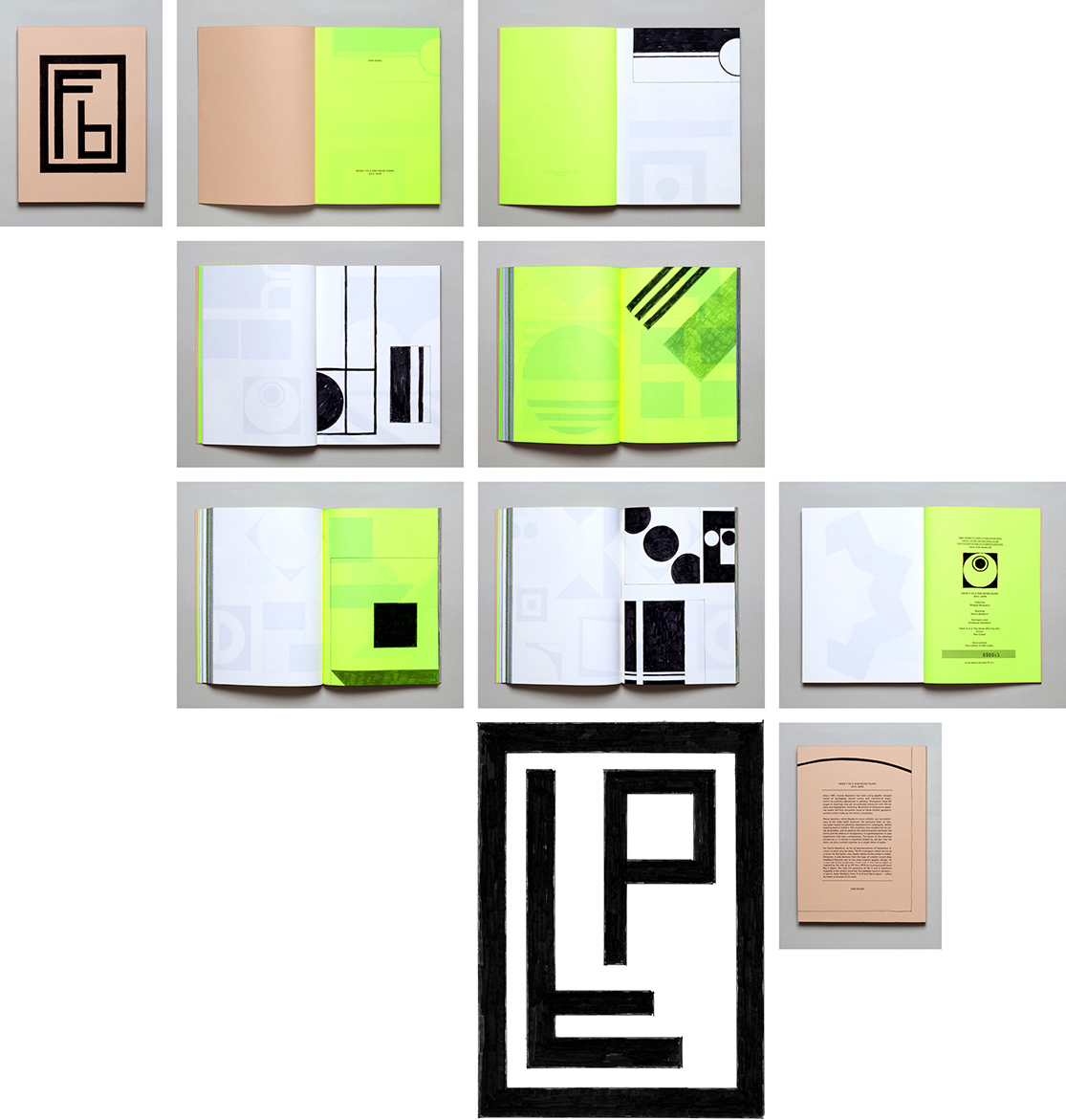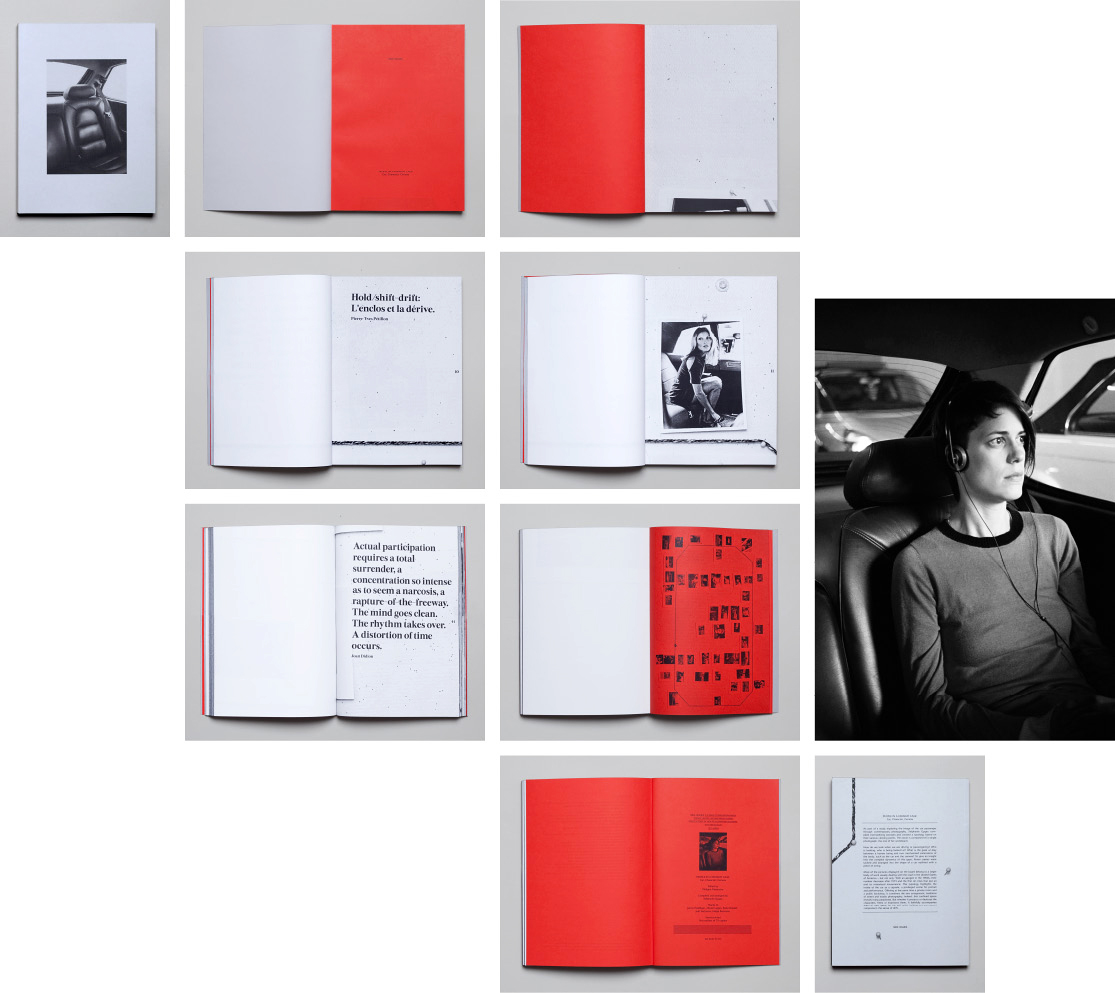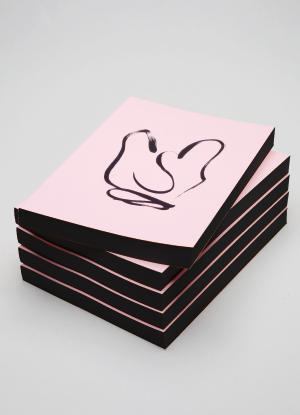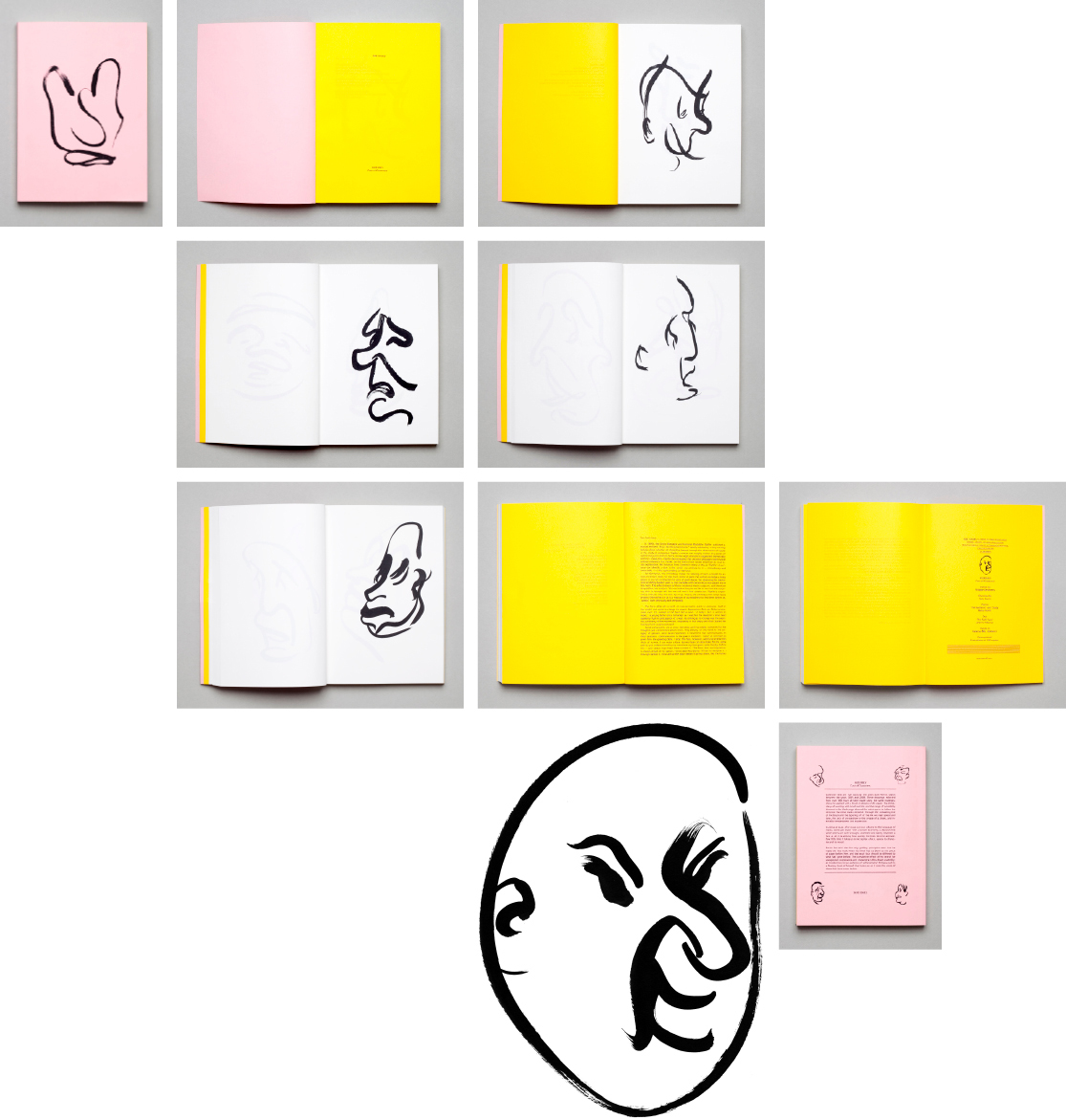Side Issues Info 1
Side Issues is about ideas
arising alongside
everyday usual business.
arising alongside
everyday usual business.
Side Issues Info 2
It is a series of publications about
science, history, art and visual
culture from the point of view of
a committed dilettante.
science, history, art and visual
culture from the point of view of
a committed dilettante.
-
FROM Y TO Z
AND NEVER AGAINA drawn index of geometrical patterns in the work of artist Francis BaudevinShow information
FROM Y TO ZAND NEVER AGAINedited by
Philippe DesarzensDrawings by Francis Baudevin
Back cover text by
Emmanuel Grandjean
148,5 / 204 mm, 168 pages
Xerox printed paperback
Book edges printed in black
First edition of 200 copiesPrice:CHF 25.00FROM Y TO Z
AND NEVER AGAIN
2015 – 2018
Since 1987, Francis Baudevin has been using graphic designs found on packaging, record covers and commercial logos, which he carefully reproduces in painting. Throughout these 82 pages of drawings that are occasionally enhanced with felt-tip pens and highlighters, including 18 printed on fluorescent paper, the reader will thus encounter some of these familiar geometric patterns which make up the artist’s vocabulary.These sketches, which Baudevin never exhibits, are not preliminary to the work itself, however. He executes them on tracing paper based on paintings reproduced in catalogues, before keeping them in binders. This inventory thus enables him to create ensembles, and to observe the interconnectionbetween the forms and the effects of transparency in superimposition to later experiment with new combinations.The layout of the drawings printed on a 1:1 format is therefore limited by the fact that the artist can place several together on a single sheet of paper.For Francis Baudevin, as for all representatives of Generation X, music is never very far away. The Fb monogram which serves as a cover for this book, very clearly relates to the author’s initials. However, it also borrows from the logo of London record shop Flashback Records and its tea shop inspired graphic design.As in the title of this publication, From Y to Z and Never Again is inspired by the title of an EP from 1978 by Liverpool punk band Big in Japan. Not only the geometry of the Y and Z resurfaces regularly in the artist’s work but this alphabet book in pictures – a nod to Andy Warhol’s From A to B and Back Again – offers an index in reverse of his work.Close information LAZY
LAZY
PAINTERCatalogue raisonné of paintings
by a robot vacuum cleanerShow information
LAZY PAINTER
edited by
Philippe DesarzensConcept, setup and photographs by
Angela Gjergjaj, Jordi Bucher, Mirco PetriniText inside by Angela Gjergjaj,Jordi Bucher, Mirco PetriniBack cover text by Tobias Klauser, Felix Pfäffli
148,5 / 204 mm, 164 pages
Xerox printed paperback
Book edges printed in black
First edition of numbered 150 copiesPrice:CHF 22.00LAZY PAINTERPictures by a robot vacuum cleaner
“Lazy Painter” is a group project featuring Angela Gjergjaj, Jordi Bucher and Mirco Petrini. It was inspired by a two-week module focusing on “Generative Design” run at Fachklasse Grafik Luzern. Generative design is the translation of complex data structures into a visual representation. The main task students face is to define rules that lead to unique designs.A good game is based on rules that allow for a certain element of surprise. Likewise, students are encouraged to devise rules, methods of design or experimental concepts that effectively generate a wide diversity of designs. In our discussions, we don’t primarily focus on the final result, but on the creative processes involved. Which parameters can be set that are neither too restrictive nor too vague, so that monotony and randomness are avoided?The shift from a merely sketch-based approach towards a comprehensive set of design rules enables visual representations to be surprising in their final result. Students no longer hesitate to bring pen to paper. Design is performed seamlessly and becomes a game. A constant game of designing and being designed.Just like that.Close information BRACES, LEVERS,
BRACES, LEVERS,
FETISHES & TALISMANSEighty-four different hand tools from the collection of Michael MarriottShow information
BRACES, LEVERS,FETISHES & TALISMANS
edited by
Philippe DesarzensTools collection and pictures by
Michael MarriottText by Neil CummingsBack cover text by Duncan Riches
148,5 / 204 mm, 182 pagesXerox printed paperbackBook edges printed in black
First edition of numbered 150 copiesPrice:CHF 25.00BRACES, LEVERS,
FETISHES & TALISMANS
Common toolsThis publication contains pictures of eighty-four different hand tools from the collection of Michael Marriott. It celebrates the objects both for their function and for their inherent beauty in repose. Accompanying the objects is an essay by Neil Cummings entitled “Look at me, Look at me, Look at me”, which was originally published in Architectural Design magazine in 2002. It explores Reyner Banham’s notion of the “furniturisation” of everyday objects, and questions why previously unselfconscious domestic artifacts are now promoted as great design.Michael Marriott is a designer based in London. A keen reader of design history, he is known for an open spirited approach to work that often makes use of pre-existing materials, manufacturing techniques or reclaimed objects. This collection is his reference point for a kind of perfect model of design, one which imagines objects as human intention given perfect form. He also enjoys them simply as things, perhaps for their shape or for how they feel in the hand.Looking through the book, one sees similarities in the collection, but also many differences. The names of the objects are both informative and wonderfully obscure; with a joggler, a dibber, a feeler, a bradawl, a stripper and a dog all in attendance.Marriott has previously written about the idea of a “rightness” in relation to hand tools. Rightness being something that one feels, rather than one particularly understands. Through ingenuity, instinct and use, these common objects have achieved a kind of rightness we can all enjoy.Close information PEOPLE IN A FARADAY CAGEA road trip through contemporary photography by Stéphanie GygaxShow information
PEOPLE IN A FARADAY CAGEA road trip through contemporary photography by Stéphanie GygaxShow information
PEOPLE IN A FARADAY CAGE
edited by
Philippe DesarzensCompiled and arranged by
Stéphanie Gygax
148,5 / 204 mm, 154 pagesXerox printed paperbackBook edges printed in black
Second edition of numbered 75 copiesPrice:CHF 22.00PEOPLE IN A FARADAY CAGE
Car, Character, Camera
As part of a study exploring the image of the car passenger through contemporary photography, Stéphanie Gygax compiled exemplifying portraits and created a typology based on their various viewing points. This book is composed of a single photograph, the one of her workboard.How do we look when we are driving or passengering? Who is looking, who is being looked at? What is the gaze at play between a human being and two mechanized extensions of the body, such as the car and the camera? To give an insight into the complex dynamics of this gaze, Xerox copies were tacked and arranged into the shape of a car outlined with a piece of string.Most of the pictures displayed on the board belong to a larger body of work usually dealing with the road in the United States of America – but not only. With an apogee in the 1960s, their number decrease after 1973 and the first oil crisis that put an end to motorized insouciance. This typology highlights the inside of the car as a capsule, a privileged scene for portrait and performance. Offering at the same time a private room and a public backdrop, it combines the two antagonistic traditions of street and studio photography. Indeed, this confined space reveals many paradoxes. But whether it protects or destroys the characters, frees or imprisons them, it faithfully accompanies them in their quest for the self while holding one permanent component: the sense of drift.Close information ASSEMBLYCast of Characters
ASSEMBLYCast of Characters
A selection of
100 faces by artist
Sam Porritt.Show information
ASSEMBLYedited byPhilippe DesarzensDrawings bySam Porritt
Text by Joanna Fiduccia
Poems by Betsy Porritt
148,5 / 204 mm, 200 pages
Xerox printed paperback
Book edges printed in black
First edition of numbered 200 copiesPrice:CHF 25.00ASSEMBLYCast of Characters
Collected here are 100 faces by the artist Sam Porritt, drawn between the years 2005 and 2008. These drawings, selected from over 300, have all been made using the same materials; china ink applied with a brush to sheets of A3 paper. The immediacy of working with brush and ink and the range of possibility inherent in the blank page allowed the artist space to follow the direction his initial marks dictated. Through the undulating line of the brush and the tapering off of the ink we read speed and tone, the arch of an eyebrow or the crease of a cheek, and inevitably temperament and expression.Looking at page after page our eye adjusts to the language of marks. Some are drawn with a certain economy; a decisive line while others are over-wrought, unsettled and barely resemble a face at all. It is striking how quickly the lines become animate, how little time it takes us to recognise a face, assess its character and its mood.Porritt has said that his only guiding principles were that he make the first mark when his mind was as blank as the piece of paper before him, and that each face should be different to what had gone before. The cumulative effect of his search for unexpected expressions and characters is this drawn assembly: an invoked cast or an audience of self-portraits? Perhaps each is a fleeting facet of himself that looks on as it joins the ranks of those that have come before.Close information YOU CAN
YOU CAN
SURF LATERA collection of engraved trench Art.
GI Zippo lighters from the Vietnam War era
by Ivan Liechti.Show information
YOU CAN SURF LATER
edited by
Philippe DesarzensProject and drawings by
Ivan LiechtiText by Sonic Boom148,5 / 204 mm, 120 pages
Xerox printed paperback
Book edges printed in black
First edition of numbered 150 copiesPrice:CHF 20.00YOU CAN SURF LATER
The hieroglyphs of the confused
Imagine being one of the young American soldiers caught up in the Vietnam War. You would have had a Zippo lighter with you, an indispensable ‘tool’ and an unfailing companion. After buying it at a supply shop from the Army, you probably would have had it personalized by a local Vietnamese engraver, or maybe you would have bought one on the black market already decorated with an engraving popular amongst your brothers-in-arms.Ivan Liechti collects pictures of engraved GI Zippos from the Vietnam War era. In this issue, he presents a collection of those artworks, redrawn and transferred onto paper in order to preserve their rather crude original appearance. The work represents a kind of modern day epigraphy.On this small metal objects, one can discover a whole world of images, a direct insight into the mind of the soldiers thrown into battle, on average only 19 years old, as well as a reflection on a troubled period of war and socio-cultural shift in the history of the USA. The pictures, apart from countless images of naked girls, explicit sexual drawings or military insignia, show that you could also have chosen a design related to your civilian life, inspired by songs you were listening to or by comic books you were reading.But in the end you might have decided simply to have your Zippo engraved with the terribly accurate:
‘WHEN I DIE I’LL KNOW I AM GOING TO HEAVEN CAUSE I SPENT MY TIME IN HELL’Close information SALT
SALT
CRYSTALThe wonder of
geometric shapes
and love
crystallization by
Fabio Parizzi.Show information
SALT CRYSTAL
Edited by
Philippe DesarzensCrystal drawings and tattooed arm
Fabio Parizzi
148,5 / 204 mm, 53 pages
Xerox printed
Book edges printed in black
Second edition of numbered 75 copiesPrice:CHF 20.00SALT CRYSTAL
the love crystallisation
As you see on the front cover of this issue, one can easily grow one’s own salt crystal at home, using a glass of salted water and a string attached to a pencil. Within few days the evaporation of water induces a shifting of matter from the water to the string as the less energetic way for sodium chloride to reorganise itself.After discovering the principle of natural salt crystallisation near Salzburg were miners used to offer to tourists dry branches
covered with a shining deposit of crystals, French writer Stendhal in his essay ‘On Love’ (1822) used it as a metaphor to describe the ‘birth of love’ in human relationships.
According to Stendhal, the mental process when one sees flattering illusions in a new love, hiding the unattractive characteristics of this person, is quite similar to the sparkly diamonds covering a leafless piece of wood after the natural crystallisation of the salt.Exploring the same phenomenon, Fabio Parizzi intended in this book to describe this chemical reaction with 50 sketches.
This visual attempt to understand the basic structure of matter in space and its physical behaviour embracies the fascination of mankind for the primary form of solid structure first described by Plato more than 2.300 years ago.Close information OLMEC
OLMEC
COLOSSAL
HEADSThe fascination for
lost civilisations
in an increasingly
virtual society by
Philippe DesarzensShow information
OLMEC COLOSSAL HEADS
Compiled and edited by
Philippe Desarzens
148,5 / 204 mm, 50 pages
Xerox printed
Book edges printed in black
First edition of numbered 50 copiesPrice:CHF 20.00OLMEC COLOSSAL HEADS
a photo album
While some call them ‘sulky babies’ while others described them as ballplayers heroes of a ritual sport played by the pre-Columbian peoples, those sculptures are widely thought to be portraits of great rulers of the Olmec civilisation dating from about 1000 BC. But if one looks at online pictures of these antediluvian faces on the Web, they appear more like a group of celebrities beside which people like to strike a pose.The customs of this lost civilisation as well as the original meaning of those colossal statues discovered in 1938 in the south of Mexico are largely unknown until the present day.
It is amazing to observe how our virtual modern culture embraces the Olmec heads, giving them a new part to play on the Web, appearing alternately as a close friend, a family member, the star for the occasion, or breaking down on the ground. From the early pictures of their discovery to holiday snapshots next to replicas in public spaces, the interaction of those mysterious characters with individuals in the same frame adds a piece of modern mythology to their interrupted past glory.By reminding us that every civilisation is destined to disappear and occasionally to be rediscovered, we can ask ourselves if our increasingly virtual society will leave such powerful symbolic objects to posterity.Close information
